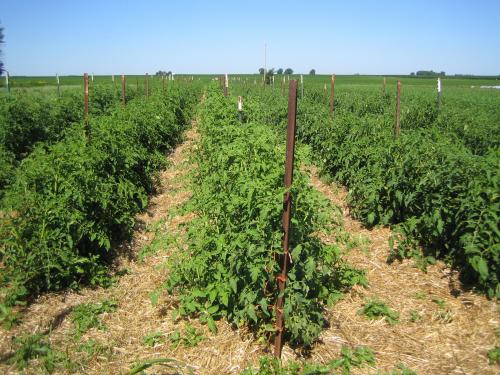eOrganic authors:
Michelle Wander, University of Illinois
Susan Andrews, USDA – Natural Resource Conservation Service
This article reviews the conservation goals for organic farming systems and considers how well organic certification standards line up with the Natural Resources Conservation Services’s programs (EQIP, transition payments) and objectives. It provides research results from an Integrated Organic Program study evaluating organic transiton strategies and compares measured trends in soil organic matter with ranks produced by NRCS tools (soil conditioning index and soil and water eligibility tools) developed to estimate conservation outcomes. It introduces the new Conservation Management tool that will be used to implement the Conservation Stewardship Program.
Implementation Varies by State
The NRCS programs and National Organic Program regulations both assess management practices, such as rotation, fertilizer additions, and tillage, as a way to evaluate stewardship. In some cases, NRCS uses producer records of practices to run models or evaluation tools that predict outcomes such as erosion, changes in organic matter, water quality, and biodiversity. Self-reporting of practices, with later field visits for verification, is also used. Organic farmers also depend on self-reporting of practices in the form of a farm management plan, called the Organic System Plan (OSP), that is a required part of their certification document. As a part of this document, organic farmers describe the practices they use to prevent runoff, manage water movement onto their farm, and prevent nutrients from leaving the farm. In addition, organic farmers are required to monitor their practices to demonstrate compliance, and maintain records of all inputs, activities, and transactions; these are examined at least annually during the certification inspection. For more on organic certification documents, see Organic Certification of Vegetable Operations.
The retains and expands several areas of support for organic. This includes support provide through the Environmental Quality Incentives Program (EQIP) in the form of payments and technical assistance for conservation practices, and for transitioning an operation to organic production, and through cost share
Organic Concerns About NRCS Enrollment Tools
The Conservation Security Program (CSP) was first introduced in the 2002 Farm Bill. Working lands provisions provided an opportunity to reward land managers already implementing conservation practices with “green payments”. The initial roll out of the CSP program caused some concern by organic farming groups that felt the program was biased against organic growers because the initial enrollment tool, called the Soil Conditioning Index (SCI), tracked tillage disturbance as a primary factor in reducing soil quality. Many producers who farm organically or live in the warmer climates have had difficulty meeting the minimum criteria for eligibility despite their strong conservation efforts. NRCS has followed up by placing greater emphasis on soil building activities, such a cover crops, mulching, compost additions and by providing expanded training for field agents evaluating practices and giving credit for improving soil biodiversity, which aides nutrient cycling, breaks pest cycles and contributes to increase soil structure, by giving credit for reduced pesticide use and diverse rotations.
Efforts to improve new tools and evaluate performance on organic farms are underway as NRCS works to implement the revised Conservation Stewardship Program contained in the 2008 Farm Bill. The 2008 Farm Bill made many improvements that should be attractive to organic farmers. One key difference is that it seeks to reward producers who have historically used good stewardship practices as well as provide iincentives for those who want to do more. It is no longer watershed based and considers the managment of the farm as a whole, not just individual fields. The new Conservation Stewarship Program will include a crosswalk to help organic and specialty crop producers access the program, as well as outreach and technical assistance to organic and specialty crop producers. It also includes a mandate for NRCS to establish a standard of care for soil, water, and biodiversity that will be predicted based on management practices. NRCS must now establish quality criteria to establish the minimum treatment level necessary to adequately address identified resource concerns for a particular land area. These criteria are described in NRCS’s Field Office Technical Guide. While there are a set of national criteria, each state may add to the criteria to make them more relevant to local conditions.
Tool Performance in the Windsor Organic Research Trial
The NRCS is working to develop and validate tools used to decide which farms—including organic farms—are eligible for program participation. This section reviews some tools that have been used and introduces the new CMT. New tools will build on existing resources including the Soil Conditioning Index (SCI), which evaluates management practices and their influence on soil status. The SCI is currently embedded in RUSLE2 (Revised Universal Soil Loss Equation 2). RUSLE2 a detailed process model that predicts long-term, average-annual erosion by water. The SCI focuses on organic matter and is computed with a weighted function:
SCI = (Organic Matter x 0.4) + (Field Operations x 0.4) + (Erosion x 0.2)
where:
Organic Matter accounts for organic material additions, biomass produced, and decomposition;
Field Operations represents physical disturbance from field operations; and
Erosion is the estimated loss of soil material by sheet, rill, irrigation and/or wind erosion.
When the SCI score is negative, soil organic matter is predicted to be decreasing; for zero or positive SCI scores, soil organic matter is predicted to be stable or increasing. For the history of this tool see Zobeck et al. (2007).
The SCI is estimated for a particular field by running the RUSLE2 model. Users provide information about the soil type and location of the field. Evaluations by NRCS suggest that tool failures often result from problems with model calibration or simple user error. NRCS is working on new expert systems, including the Soil and Water Eligibility Tool (SWET) and products derived from this tool. SWET evaluates management practices based on their contribution to each soil function or water quality concern. The soil properties that SWET scores include organic matter, nutrient cycling, soil habitat, physical stability, and moisture management. The water quality properties SWET scores are sediment, salinity, and surface and groundwater pesticides, nitrogen, and phosphorus. A new conservation compliance tool that is based on SWET is now under development and will be used to determine eligibility for future NRCS programs. Fig. 2 shows the entry screen for this prototype tool. An expert system will be used to determine what practices meet the standards of care established for soil and water resources. Assumptions about practice impacts on soils predict outcomes for soil (organic matter, nutrient cycling, soil physical condition, soil biotic habitat, and soil moisture salinity management) and water quality (leached N, P, and pesticides; sediment loss). Initial validation efforts have compared tool results with measured soil quality data from medium- and long-term research plots (Wienhold et al., 2007; Zobeck et al. 2007).
Figure 2. Screen shot from the SWET tool. The NRCS has already adapted this and incorporated it into a new Conservation Management Tool (CMT).
Table 1 shows the results from an evaluation of NRCS tools (SWET and SCI) and compares them with the soil organic carbon (SOC) concentrations actually measured in the surface soils of replicated research plots in an organic transition experiment in Champaign, IL. Three transitional cropping systems (intensive vegetable, row crop, and perennial pasture or ley), each with three approaches to fertility (crop and cover crop residues only, and residues supplemented with either manure or compost additions), were compared during 2003–2005. For all treatment combinations, the SOC levels increased slightly during the study compared to baseline samples taken at the beginning of transition.
| SWET2 | SCI3 | Year 3 SOC | ||||
|---|---|---|---|---|---|---|
| Treatment1 | Score | Eligible? | Score | Eligible? | (%)4 | |
| VEG | 44 | no | -0.46 | no | 2.45 ± 0.72 | |
| VEG + manure | 52 | no | 0.86 | yes | 2.36 ± 0.80 | |
| VEG + compost | 52 | no | 2.80 | yes | 2.39 ± 0.63 | |
| ROW | 64 | yes | -0.12 | no | 2.17 ± 0.41 | |
| ROW + manure | 72 | yes | 1.60 | yes | 2.28 ± 0.58 | |
| ROW + compost | 72 | yes | 3.60 | yes | 2.37 ± 0.40 | |
| LEY | 101 | yes | 0.98 | yes | 2.50 ± 0.31 | |
| LEY + manure | 109 | yes | 2.40 | yes | 2.55 ± 0.38 | |
| LEY + compost | 109 | yes | 3.70 | yes | 2.24 ± 0.63 | |
1 Cropping system and soil amendment treatment. VEG = diversified vegetable rotation; ROW = grain and oilseed rotation; LEY = perennial grass and legume forage.
2 SWET – Soil and Water Eligibility Tool
3 SCI – Soil Condition Index
4 Soil organic carbon, mean ± s.d., n=4
The SWET scores in Table 1 suggest the more-intensively managed vegetable cropping system would degrade soil and water quality, and thus be ineligible for CSP participation. Measurements of SOC suggest this prediction would be false at this site. SWET scores tended to be lower for scenarios without organic matter additions but not enough to change eligibility status based on SWET. Manure and compost addition made a bigger difference in the SCI predictions. Negative SCI scores for the vegetable and row cropped systems without supplemental manure or compost additions predicted a decline in soil organic matter that would have made them CSP ineligible. SOC measured indicate organic matter levels held even where cover crops were the sole source of fertility. In our comparison, both SWET and SCI appeared to overvalue the benefits of supplemental organic matter (particularly compost) additions and the use of perennial pasture and undervalue the benefits of cover crops, particularly in the vegetable cropping system.
Additional Resources
- To learn more about EQIP, transitioning to organic agriculture, RC&D’s and the additional assistance available from NRCS, contact your local USDA Service Center or visit http://www.nrcs.usda.gov/ (verified 10 March 2010).
- 2008 Farm Bill Side-by-Side [Online]. United States Department of Agriculture—Economic Research Service. Available at http://webarchives.cdlib.org/sw1vh5dg3r/http:/ers.usda.gov/FarmBill/2008/ (verified 10 March 2010).
- Conservation Stewarship Program [Online]. United States Department of Agriculture—Natural Resources Conservation Service. Available at: http://www.nrcs.usda.gov/wps/portal/nrcs/main?ss=16&navid=100120300000000&pnavid=100120000000000&position=SUBNAVIGATION&ttype=main&navtype=SUBNAVIGATION&pname=Conservation%20Stewardship%20Program%20|%20NRCS (verified 10 March 2010).
- For more on the Conservation Benefits of Organic Production go to: http://organicecology.umn.edu/archive/category/education-outreach/page/2/
- For more on Farm Beginnings programs see these websites:
- Minnesota Farm Beginnings, http://www.landstewardshipproject.org/farmbeg.html (verified 10 March 2010)
- Stateline Farm Beginnings, http://www.learngrowconnect.org/what/training/stateline (verified 10 March 2010)
- Central Illinois Farm Beginnings,
Read more here:: Organic Certification and Soil Conservation Compliance






